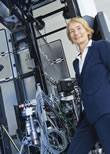SALVE III microscope moves to the new microscopy building at the University of Ulm.
September 28, 2017 - There is something to celebrate at Ulm University: the SALVE microscope comes home!
It took 10.6 million Euros for the development and construction of the four-meter-high and tons-weight unit. The SALVE microscope is the first and so far the only low-voltage transmission electron microscope (TEM) with chromatic and spherical aberration correction worldwide. „This technology makes it possible to visualize individual atoms, and to detect their movements and interactions in a wide field of view with unprecedented resolution at accelerating voltages as low as 20 kV. It is therefore ideally suited for the investigation of many radiation-sensitive materials such as ultra-thin materials by electron microscopy,“ explains the head of the SALVE project, Professor Ute Kaiser.
Video 1. The arrival of SALVE.
The abbreviation SALVE stands for „Sub-Ångström Low Voltage Electron microscopy“ and is the acronym for a research initiative of the University of Ulm for the development of atomic resolution electron microscopy in the energy range from 20 to 80 keV, which has been running since 2009. Since the completion of the instrument in April last year, it was at the company CEOS GmbH in Heidelberg (Germany), which has developed the electron-optical corrector system. The partner for the manufacturing of the microscope is the company FEI (now ThermoFisher) based in Eindhoven (Netherlands) and Hillsboro (USA). From Heidelberg the SALVE microscope was now transferred to its new domicile at the University of Ulm.
The microscopy building is plain, doesn’t look like much, but it has a lot to offer!
Construction works of the new microscope building have been startet in March 2016. Now it has been completed on time for the move. The two-storey concrete building seems rather inconspicuous from the outside, but has a lot to offer. The purpose-designed construction must fulfill the highest requirements for the perfect operation of the unique low-voltage microscope. The electron microscope SALVE must be set free of vibrations and shielded from interfering magnetic fields in a temperature-stable environment.
The base contains a separate plate for TEM on passive air suspension. By this plate, the two TEM chambers are elastically mounted. The 3.85 million Euro building is also shielded against electromagnetic radiation and additionally equipped with a so-called magnetic field compensation system. With the special „house in house“ construction and the actively stored special foundation, the new microscope building offers a special protection against vibrations. The costs are shared between the municipal utilities of the City of Ulm (44 %) the University of Ulm (37%) and the state of Baden-Württemberg (19%).
All specifications have been fulfilled or over-fulfilled: Sound adsorption, mechanical vibrations, magnetic field cancelation, and temperature stability. The TEM room has a usable volume of 6 x 6 x 6 m3 (Figure 6). It has 5 water cooled walls with a temperature stability of 0.5°/24 hours. Dedicated active magnetic field cancelation reduce the magnetic field fluctuation to < 1 nT. The dedicated noise cancelation as well as the special walls and doors reduce the acoustic vibrations to < 30 dB, which is 100 times below the specifications and the vertical vibration is reduced to < 35 µg (Figure 9). The vertical vibration is reduced to < 0.35 μg. There is no disturbance by the user as the microscope is remote controlled.
This Thursday, September 28th, the truck arrived in front of the light gray SALVE new building. In numerous boxes are the parts of the new microscope (Figure 2). After mounting (Figure 3) and commission, the scientists of the Group of Electron Microscopy for Materials Science at the University of Ulm (Figure 4) will finally be able to continue their studies on novel 2D materials, hybrid materials and thin biological materials on the SALVE instrument. Whether in material or quantum sciences, battery research or molecular biology - the SALVE microscope will give them unique insights into the world of atoms. The development and construction of the fully corrected low-voltage TEM was funded by the German Research Foundation, the state of Baden-Württemberg, the University of Ulm and the Carl Zeiss Foundation.




